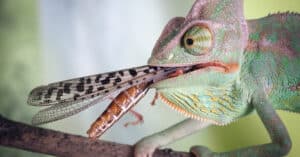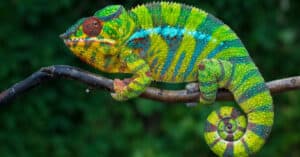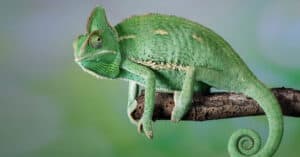The chameleon is one of the thousands of lizard species in the world. There are over 160 species of these lizards spread across Madagascar, Spain, Africa, Asia, and Portugal. Like all other lizards, the chameleon is very unique. However, because of its ability to alter its skin tone to blend in with its environment, it is most likely the most unusual lizard on the entire planet. These lizards like to live in trees or bushes, and some species live on the ground, under leaves.
The size of these lizards varies according to their species, but even the largest species do not grow past 24 inches in length. All chameleons are insectivores and use their extended tongue to catch their prey. However, despite their ability to camouflage themselves at will to hide from predators, these lizards, like others, are at the bottom of the food chain. In this article, we will examine the diet of these animals and their poop- what it looks like, how much they poop, and whether or not their poop is dangerous.
What Do Chameleons Eat?
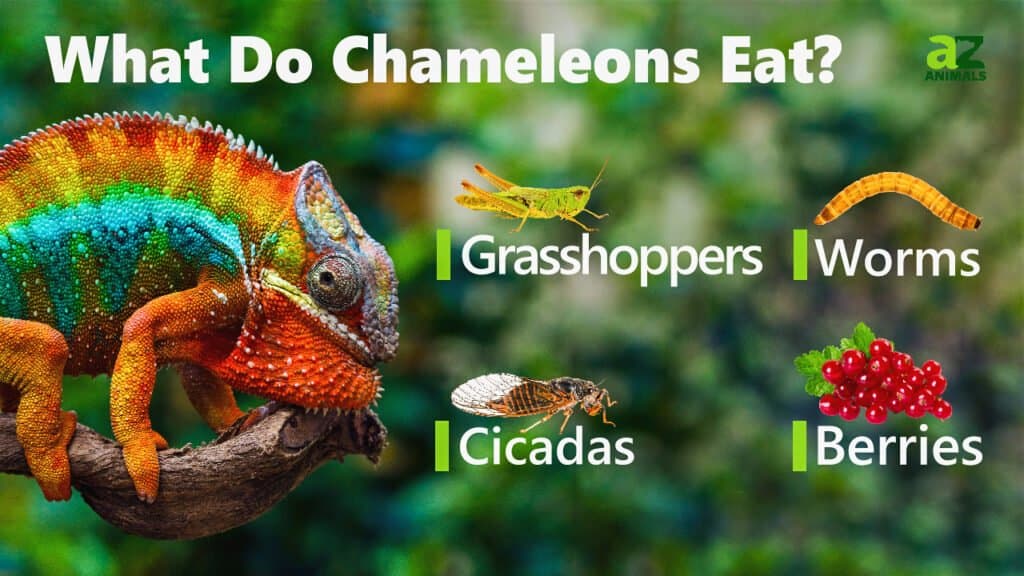
Chameleons are insectivores, meaning they mostly eat insects. However, because of their environment, which might be food-scarce, they will occasionally also opportunistically ingest vegetation. Small insects, mostly used as a source of protein, make up most of the chameleon’s diet. The diet of chameleons depends on their size. Smaller species, like the veiled chameleon, mostly eat plants and small insects. Other larger chameleons, like the Malagasy giant chameleon, can consume other reptiles, small birds, and larger insects.
The chameleon’s diet is made up of insects like grasshoppers, flies, cicadas, snails, caterpillars, and silkworms. Younger chameleons under the age of one require more food than adults; they can eat anywhere from 12 to 18 small insects a day, usually spread out into two feeding sessions. In the wild, adult chameleons are opportunistic eaters, which means they consume food whenever they come across it. They can go for weeks without eating if they don’t find any, as long as they have access to water.
What Does Chameleon Poop Look Like?
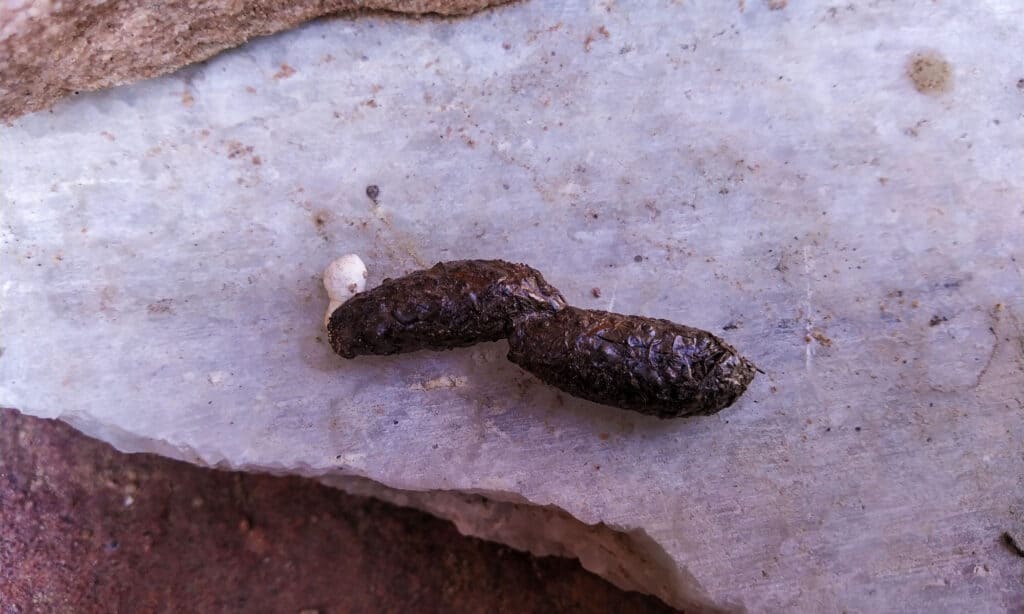
Chameleon poop is oval-shaped and should normally be soft and firm.
©Suthar Naveen P/Shutterstock.com
Unlike many animals that poop almost every day or even a few times daily, chameleons only poop once every few days. Also, like most animals, chameleons poop out of a hole in their rear. These animals lift up their tails and push out their behind as an indicator that they are about to poop. Chameleons are also generally pretty clean but are extra clean when doing their business. Chameleons that live in enclosures like to pick a particular spot to poop every time.
A chameleon’s poop forms an oval shape and is generally made up of two parts. The first part is usually black or brown and usually looks relatively mushy, with some moisture in it. This portion of the excrement typically has no odor and contains all of the chameleon’s digestive waste. While a diet consisting primarily of silkworms or hornworms may cause the excrement to be a little runny, it should normally be soft and firm, and create a good oval shape.
The other part of a chameleon’s poop is usually a white color and is called the urate. Chameleons do not pee as many other animals do. Like some other animals, chameleons manufacture urea in a solid form and poop it out in a solid white lump rather than eliminating their liquid waste in the form of urine as we do. The reason chameleons pass urate instead of urine is so they can retain more water for hydration.
The color of a chameleon’s urate should not be bloody, watery, or runny. The color may vary from white to yellow, but an orange color means the chameleon is not getting enough water. However, a chameleon’s urate may be orange-looking if it has not pooped for a while. Because more water has been absorbed over time and the urate has been resting in your chameleon’s system for a longer period of time, the color of the urate changes from the usual white to almost orange.
How Often Do Chameleons Poop?
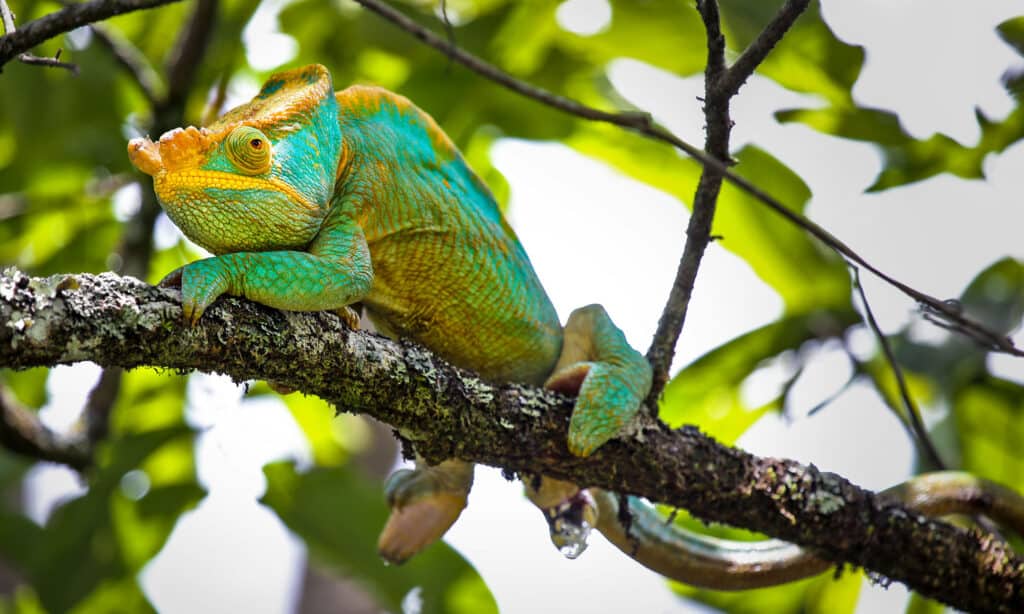
Chameleons poop less frequently, usually once or twice per week.
©Ryan M. Bolton/Shutterstock.com
The number of times a chameleon poops depends on how much it eats, when it eats, and other factors. Depending on how much and how often they eat, chameleons typically poop once every few days. However, if no stool has been generated in more than two weeks, there may be a problem. Baby chameleons poop more frequently than adults; these young ones poop at least once daily and maybe more because they have more appetite than adults. Most adult chameleons poop less frequently, usually once or twice per week.
Is Chameleon Poop Dangerous?
Although there has been no case reporting any health hazards faced by humans due to chameleon poop, like poop from all types of animals, chameleon poop is relatively dangerous to human health. Like most reptiles, chameleon poop could contain Salmonella. These bacteria are naturally present in healthy chameleons’ digestive tracts and can be transmitted through their poop, capable of infecting humans. In humans, the presence of Salmonella can cause diarrhea, fever, and stomach pains.
Chameleons are also very susceptible to parasites such as roundworms and tapeworms. These parasites can be passed through their poop, and when they come in contact with humans, these parasites can affect humans in several ways. Roundworms pose a significant risk to humans; once infected, humans can suffer from eye, lung, heart, and neurologic problems.
On the other hand, the presence of tapeworms in humans can cause weakness, diarrhea, nausea, weight loss, loss of appetite, and abdominal pain. In some cases, tapeworms can cause major issues such as intestinal blockage or damage to the intestine’s tiny channels like the bile duct or pancreatic duct. The liver, eyes, heart, brain, and other organs may suffer harm if the tapeworm larvae leave the intestine and travel to other regions of the body. Another serious condition tapeworms can cause is cysticercosis. Among the most obvious signs of cysticercosis in humans are frequent seizures, severe headaches, blindness, and convulsions.
Up Next:
Chameleon Lifespan: How Long Do Chameleons Live?
The Best Cages for your Chameleon for 2022
Hummingbird Poop: Everything You’ve Ever Wanted To Know
The photo featured at the top of this post is © iStock.com/michaklootwijk
Sources
- Pawfect Paw Print, Available here: https://pawfectpawprint.com/chameleon-poop-everything-you-need-to-know/
- Chameleon Owner, Available here: https://chameleonowner.com/chameleons-poop/
- Chameleon Forums, Available here: https://www.chameleonforums.com/threads/chameleon-poop-101.120171/
Thank you for reading! Have some feedback for us? Contact the AZ Animals editorial team.



